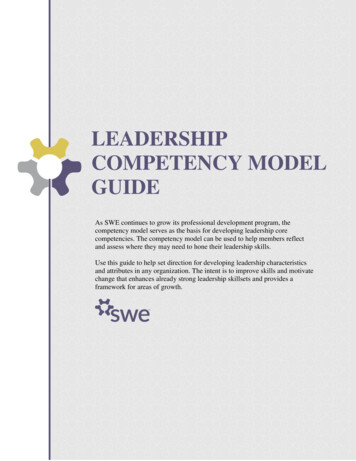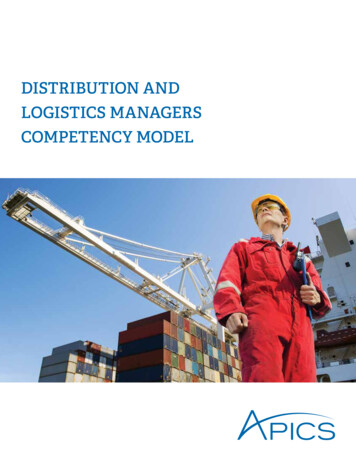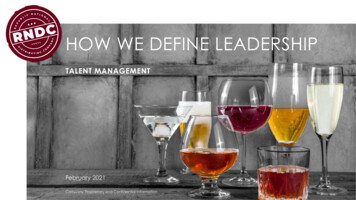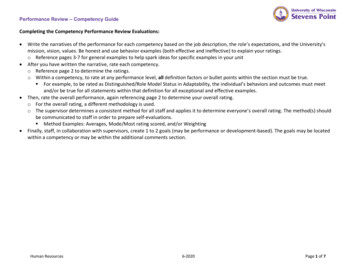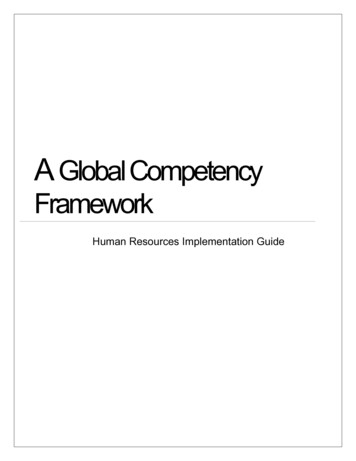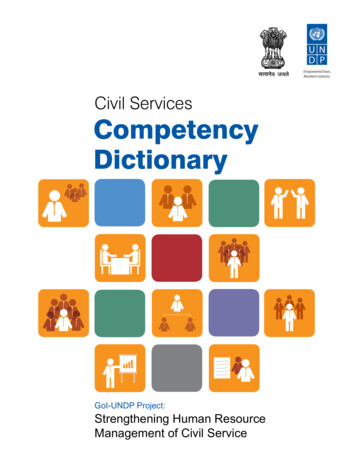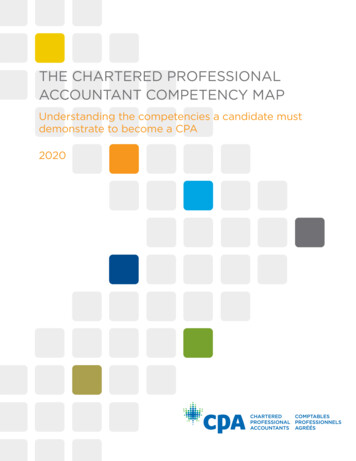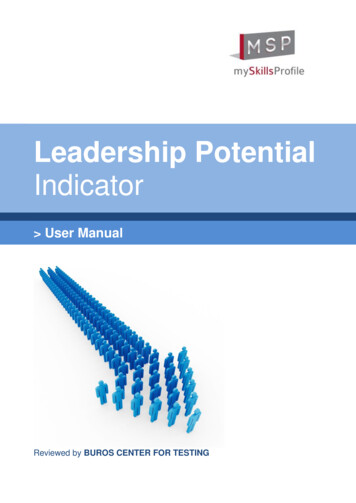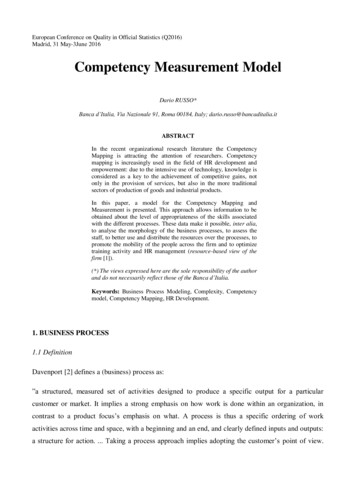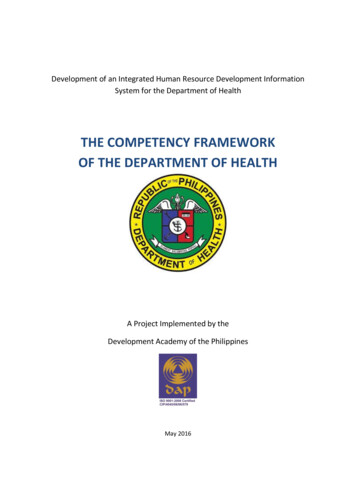
Transcription
Leadership CompetencyModel“If your actions inspire others to dream more, learn more, do more,and become more, you are a leader.”—John Quincy Adamspoint of viewThe Competencies Required forEffective Leadership
Point of View Leadership Competency ModelIn the 50 years that Wilson Learning has studied leadership and has helpedits clients develop their approaches to leadership, we have come to believethat how leaders view their purpose will set the course for their organization’ssuccess. Wilson Learning’s paper “Developing Great Leaders: IntegratingLeadership Character and Skills” presents our point of view that effectiveleadership is a balance of values-driven character (Essence) and skills andcompetencies (Form). In this paper, we review the specific integration of bothEssence and Form.Integrated Leadership: The Balance of Essence and FormWilson Learning’s approach to assessing and developing leaders was createdwith the intent of tapping both the Essence and Form of leadership. Essence iscaptured in what we call Leadership Character—those elements of leadershipthat are core to how people view the purpose of leadership. Form representsthe skills and knowledge needed to take action on these Leadership Characterelements. While distinct, both aspects are critical to effective leadership.Leadership Character: The Essence of LeadershipLeadership Character is comprised of values, characteristics, and clarity ofpurpose that determines what one wants to be as a leader. It is expressed inthe consistency of behavior—the degree to which a leader’s actions match hisor her words.Our research has identified 18 individual Character factors that have beenlinked to leadership success. Wilson Learning categorizes these into threeprincipal components: Personal Character, Social Character, and Organizational Character. Effective leaders demonstrate a balance of all three componentsas core values. Leadership Character is expressed differently in different leadership positions, but is always a critical element of effective leadership.Key Aspects of Leadership CharacterPersonal CharacterSocial CharacterOrganizational CharacterStaying steadfast anddecisive in the face of adversityShowing others respect, being compassionate, and valuing individualdifferencesWillingness to put organization andcustomer needs ahead of personalneeds Risk-TakingInitiativeDriveSense of UrgencyTenacityResilienceFlexibilityStress ManagementIntegrityCompassionProprietyValues DiversityCooperativeAccessible Wilson Learning Worldwide Inc.WilsonLearning.com 1.800.328.79372EthicalCustomer FocusLeadership CourageOrganizationalCommitment
Point of View Leadership Competency ModelForm: The Four Roles of LeadershipWhile Leadership Character is the foundation of effective leadership, it aloneis not sufficient. Unless this foundation is supplemented by the skills andknowledge required to execute on those values and principles, the leader failsto produce the tangible results necessary for creating organizational success.Based on both in-depth research and practical experience, we have foundthere are a number of skills required to execute effective leadership. Theseskills, which comprise the Form aspect of leadership, can be organized intofour core roles that each leader must fulfill: The Visionary role focuses on setting direction by translating strategy intowork group requirements. The Tactician role ensures activity toward that vision, achieving resultsby effectively planning work, delegating responsibility, and reviewingperformance. The Facilitator role makes sure everyone is appropriately involved, creatingan environment of collaboration and partnership to ensure effectiveworking relationships. The Contributor role ensures the leader’s own talents, experiences, andabilities are being applied to create organizational success.These four roles define the seemingly contradictory responsibilities of aleader—often considered the greatest challenge of leadership. Being a greatleader means being able to effectively balance these four roles and successfully integrate them with Leadership Character.Wilson Learning’s Integrated Leadership ModelSOCIAL Wilson Learning Worldwide Inc.WilsonLearning.com 1.800.328.79373“It is only with the heart thatone can see rightly. What isessential is invisible to the eye.”—Antoine de Saint-Exupéry
Point of View Leadership Competency ModelProfiles of LeadershipAll leaders, regardless of level, need to fulfill all four roles. But the relativeimportance of each role will vary, depending on the specific responsibilities ofthat leader. As described in “Understanding Leadership Development:Integrating Essence and Form,” most organizations develop leaders basedupon three common levels: First-level leaders—Managers and supervisors of individual contributors“Leadership is not magneticpersonality. It is not ‘makingfriends’ and influencing people.Leadership is lifting a person’svision to high sights, andraising performance to a higherstandard.”—Peter Drucker Mid-level leaders—Managers of departments or functions, managers ofmanagers Executive leaders—Executives responsible for the overall leadership andculture of the organizationFirst-Level LeadershipFirst-level leaders are often making a difficult transition from being an individual contributor responsible only for their own performance to being a leaderwho adds value by getting work doneVisionarythrough others.To accomplish this transition—and ensuresustained success—a new first-levelleader must quickly acquire the necessaryTacticianLeadership Survival Skills. These survivalskills are primarily found in the Tacticianand Contributor roles, given the first-level leader’s responsibility for ensuringtasks are completed and objectives met. This requires the first-level leader toensure all employees are adding value, while also making decisions that arein the work group’s best interests. While these leaders will need to effectivelytranslate organizational strategy into day-to-day work group objectives—andwill occasionally have to lead team efforts—most of their time is spent on thetactical aspects of “getting the job done.”FacilitatorContributorFirst-Level Leadership CompetenciesVisionaryUnderstanding andtranslating strategy intowork group requirementsTacticianEnsuring results areachieved by effectivelyplanning work, delegatingresponsibility, andreviewing performanceFacilitatorCreating an environment ofcollaboration andpartnership to ensureeffective workingrelationshipsContributorCreating organizationalsuccess by contributingtheir personal talents,experiences, and abilitiesKEY FIRST-LEVEL COMPETENCIES Setting Work Group ObjectivesDeveloping Employees Coaching & FeedbackMotivating Employees ManagingPerformanceSetting EmployeeGoalsPlanning Work TasksCoordinating WorkActivitiesDirecting TasksDelegating TasksHiring & StaffingFocusing on Quality Wilson Learning Worldwide Inc.WilsonLearning.com 1.800.328.79374 DemonstratingInterpersonalVersatilityResolving ConflictCommunicatingLeading Groups UnderstandingBusiness IssuesMaking DecisionsContributing to TeamsManaging TimeDeveloping Self
Point of View Leadership Competency ModelWhile these survival skills occupy much of the development focus, thesefirst-level leaders are also going through an Essence transformation. Afirst-level leader needs to establish what he/she wants to be as a leader—whatwe call Establishing Leadership Credibility. First-level leaders must understandhow their character affects the performance of their work group in order tosuccessfully transition their source of credibility from technical expertise toleadership.VisionaryMid-Level LeadershipAs leaders move into mid-level leadership,their focus shifts from one-to-one survivalFacilitatorskills to more one-to-group developmentskills. This focus on what we call GrowthSkills means mid-level leaders requireTacticianmoderate to strong skills in all four leadership roles. Mid-level leaders are expectedto execute on strategy, even though they may not have been involved in theactual formation of that strategy. They often need to work with and influencepeers over whom they have no authority and confront interpersonal conflictwithin the organization. Mid-level leaders also require strong tactical skills asthey manage other managers in accomplishing group objectives. They are alsooften called upon to contribute their unique talents to solving functionallyspecific problems or making critical decisions. Without a doubt, mid-levelleaders wear many hats.Mid-Level Leadership CompetenciesVisionaryTacticianUnderstanding andtranslating strategy intowork group requirementsEnsuring results areachieved by effectivelyplanning work, delegatingresponsibility, andreviewing performance FacilitatorContributorCreating an environment ofcollaboration andpartnership to ensureeffective workingrelationshipsCreating organizationalsuccess by contributingtheir personal talents,experiences, and abilitiesKEY MID-LEVEL COMPETENCIES Communicating Vision& PurposeDeveloping Structures& ProcessesUnderstanding theCompetitiveEnvironmentKnowing One’s OwnOrganizationDirecting OutcomesDelegating DecisionsManaging Budgets &Expenses NegotiatingPersuading OthersListeningSpeaking EffectivelyLeading TeamsAdapting to CulturalDifferences UnderstandingBusiness IssuesMaking DecisionsUnderstandingBusinessFundamentalsThe role of Essence also grows in mid-level leadership. While mid-level leadersdo need to add to the foundational skills developed as first-level leaders, theirneed for character development (Essence) expands significantly. If the Essencetransition for first-level leaders is to Establish Leadership Credibility, theEssence transition for mid-level leaders is to become a Purpose- andValues-Centered Leader. Wilson Learning Worldwide Inc.WilsonLearning.com 1.800.328.79375Contributor
Point of View Leadership Competency ModelWhen mid-level leaders develop Purpose- and Value-Centered LeadershipEssence, depth of character becomes more important than appearance ofpower. They take action based on values, not on short-term gains. Success ismeasured by their contributions to others, not title or salary. And life is livedon purpose, not on approval from others.Executive LeadershipAs leaders reach the executive level, the need for additional skills shifts moretoward organization-level strategic skills. The primary roles of the executiveleader are Visionary and Facilitator, as these leaders are expected to drivechange, create a vision for the organization’s future, and develop strategiesfor achieving that vision. To accomplish this, executive leaders need strong Facilitator skills to get diverse functions and employee groups working togethertoward a shared positive future.VisionaryFacilitatorContributorTacticianThe Tactician skills inherent to this level are usually limited tosupporting functional managers’ tactical leadership efforts,whereas Contributor skills are typically reserved for morecritical situations. Executive-level leaders who spend a lot oftime in Tactician and Contributor roles are not viewed as beingeffective because they clearly have not sufficiently developedtheir next line of managers.Executive Leadership CompetenciesVisionaryTacticianUnderstanding andtranslating strategy intowork group requirementsEnsuring results areachieved by effectivelyplanning work, delegatingresponsibility, andreviewing performance FacilitatorCreating an environment ofcollaboration andpartnership to ensureeffective workingrelationshipsContributorCreating organizationalsuccess by contributingtheir personal talents,experiences, and abilitiesKEY EXECUTIVE COMPETENCIES Creating Vision &PurposePlanning StrategyLeading ChangeCultivating a LearningEnvironment Setting OrganizationalGoalsDirecting Strategy NegotiatingListeningPresenting to Groups Making StrategicDecisionsAs one would expect, the core of effective executive leadership is Essence. Werefer to this as Culture-Centered Leadership because the responsibilities shiftto elements that shape organizational culture—the consistency of communication and action, integrity and transparency, and being the example for otherleaders and employees to follow.Integration of Essence and FormIn the end, effective leadership is about integrating Essence and Form—clarityof purpose for what one wants to be as a leader, and the ability to execute theroles of the Visionary, the Tactician, the Facilitator, and the Contributor. Only Wilson Learning Worldwide Inc.WilsonLearning.com 1.800.328.79376
through this integration of Essence and Form can a leader effectively createthe conditions for achieving performance with fulfillment and engageothers in fully committing their energy, creativity, and talents. Today’sbusiness climate requires leaders who are role models for this integration—leaders who express an excitement about the possibilities of leadership.To them, leadership is being of service to others. And despite the manychallenges they face, effective leaders exude a profound energy, a contagiousexcitement, and an undying hope about the future that is inspiring toeveryone around them.So, what can you do to help your leaders successfully integrate Essence andForm? It begins by understanding the key challenges facing your leaders ateach level of the organization. From there, identify the key competenciesneeded to address these challenges, and take the time to carefully assess skillgaps—in other words, how do your leaders’ current skill levels compare towhat they need in order to be fully successful in their roles? With this understanding in place, your focus can then shift to identifying the best development strategies for closing those gaps, helping your leaders create theconditions for organizational success.To learn more about transforming your current and future leaders, pleasecontact Wilson Learning at 800.328.7937 or visit WilsonLearning.com.About Wilson LearningFor more than 50 years, Wilson Learning has been equipping organizationsaround the globe to drive productivity, solve problems, and increase revenue.We do this by developing leaders, the workforce, and sales and service organizations. Our unique blend of content, combined with state-of-the-art deliverytechnology and implementation expertise, ensures sustainable results. Theresult is high-impact, performance-driven solutions for your organization.Wilson Learning Worldwide8000 W. 78th Street, Suite 200Edina, MN 55439WilsonLearning.com Wilson Learning Worldwide Inc.All Rights Reserved.7“I am convinced that theoverwhelming majority of allemployees are able to committheir total skills and energiesto corporate goals only ifthey believe those goals to bemeaningful.”—Jack J. Crocker,Former CEO, SuperValu Inc.
Ensuring results are achieved by effectively planning work, delegating responsibility, and reviewing performance Creating an environment of collaboration and partnership to ensure effective working relationships Creating organizational success by contributing their personal talents, experiences, an
